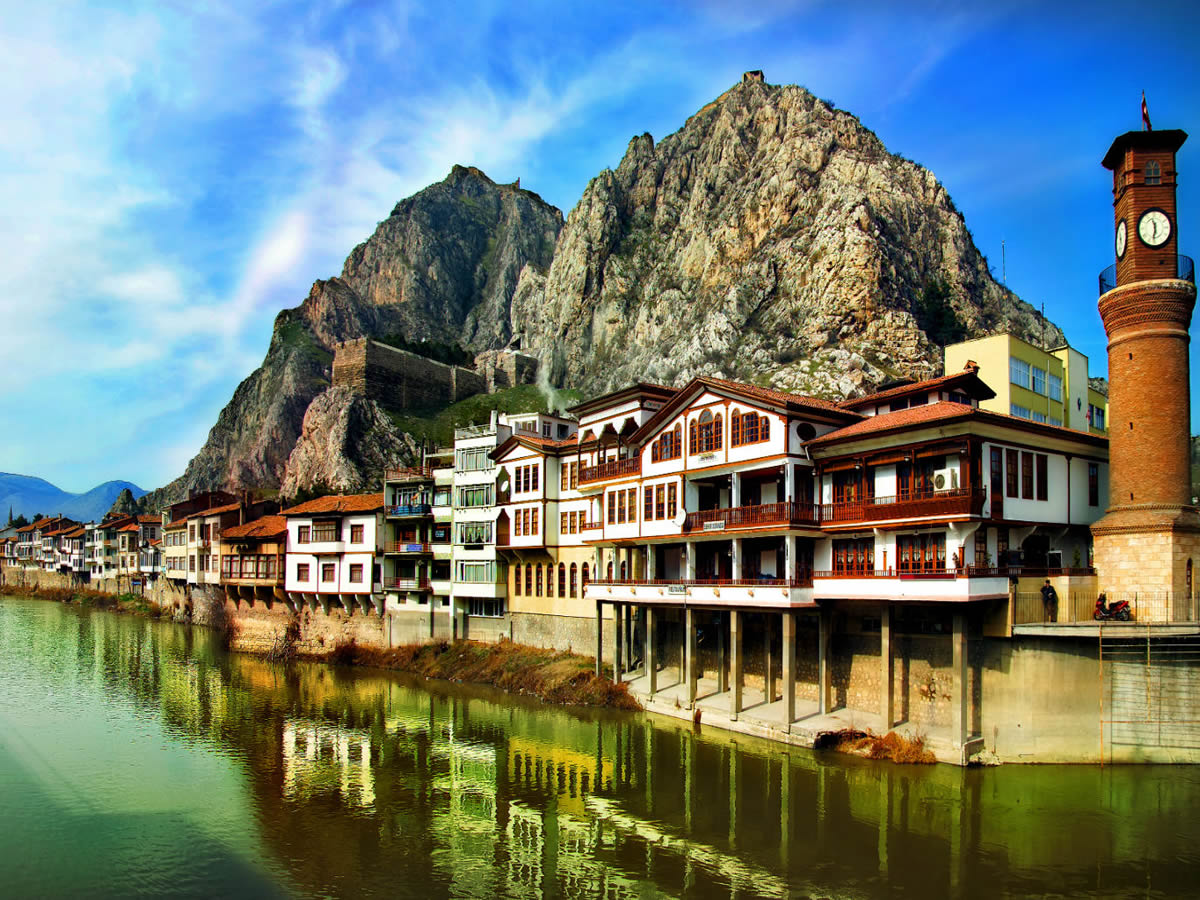In an idyllic river valley lies the city famed for its extraordinary beauty, Amasya. Faruk Pekin explores its rich history, diverse cultural traditions and fascinating sights.
MY native town is situated in a deep and large valley through which flows the river Iris. It has been provided in a surprising manner by art and nature for answering the purpose of a city and a fortress.” Thus wrote Strabo, geographer of the ancient world of the city of his birth.
Nestled at the foot of precipitous lead colored rock cliff’s and spread out into the plain formed by the Iris river, now called the Yeşilırmak, Amasya is arguably central Anatolia’s most beautiful city. Despite the destruction wrecked by numerous earthquakes, floods and fires, the city has retained its traditional texture. Picturesque half-timbered houses with broad eaves, carved wooden decoration, bay windows and balconies which overhang the river line cobbled streets. Mulberry and other fruit trees as well as elegant tall poplars carpet the river plain and add to Amasya’s reputation for beauty.
A Turbulent History
Amasya’s heritage rests on a rich history of many different cultures stretching back to the Chalcolithic age (5500-3500 B.C). In the Hittite period (1900-1200 B.c.), it was one of the 13 states that formed the Amasit confederation. Subsequently the Phrygians, Lydians and Persians controlled the city until the conquest of Alexander the Great. During the Hellenistic period the city was known as Amaseia having been given this name, according to Strabo, in honor of its founder, the Amazan queen Amasis.
In 291 B.C. Amasya became the capital of the Pontic kingdom that was ruled by a succession of monarchs named Mithradates. These rulers attempted to create a synthesis of the Hellenistic and Persian cultures in Anatolia. Today, the rock-carved tombs chiseled into the cliff face remain as a legacy of the Pontic kingdom.
The Pontic kings warred constantly with the Romans for 500 years before succumbing to Julius Caesar in 47 B.C. at Zile. It was after this easy victory that Caesar uttered his famous declaration: “Veni, yedi, vedi ” (I came, I saw. I conquered!)
After 395 AD, Amasya passed under the control of the Byzantine Empire although for short periods, it was ruled by the Peçeneks, Persians and Arabs. In 1075, the city came under the control of the Danishmendid Beys and in 1143 of the Seljuk sultans.
Located on the famous royal road of the Persian Empire, Amasya was a commercial center at the junction of the trade routes of the ancient world and gained renown for its silk weaving and copper metalwork as well as for its crops of luscious apples.
Between 1243–1341 the Mongols and IIkhanids controlled the city; between 1341–1381 the Ertena Beys govemed it. In 1389 the Ottomans took Amasya, although it was later attacked by Tamerlane. Under the Ottomans, Amasya was the city of princes. The Ottoman sultans Mehmet the Conqueror, Beyazıt I, Beyazıt II, and Murat III all served as governors of Amasya before ascending to the throne.
The publication of the Amasya Tamimi, the document which directed the struggle before the Turkish War of Independence, on June 21-22, 1919, gave the city a place of honor in Turkey’s modem history.
Amasya’s turbulent political history exposed it to a variety of religious influences. Following its importance as a patriarchate during the Byzantine period, in the Seljuk period the city was home to intense discussions between the four great Islamic schools of law. Support was found for Sunni beliefs as well as for Shi’ite and Batıni traditions. Besides Sunnis and Alevis, there were a great number of Christians in Amasya and the nomadic Turcomans who were settled in Amasya continued their shamanistic traditions for a long time.
A Wealth of Sights
As you enter Amasya from the south, the first monument you see is the Gök Medrese, or theological college, more closely resembles a great mosque (Ulu Cami) than a religios school and is famed for its stone portal. The cobalt blue tiles on the building’s exterior gave it its name, sky.
Once in the city, a pleasurable tour begins with a cup of coffee in one of the charming cafes which line the east bank of the Yeşilırmak river (whose reddish color belies its descriptive name, green). These rest stops offer a peaceful setting from which to view the traditional houses squeezed between the river and the steep cliffs punctuated with rock-carved tombs. One of the houses, which was built by Finance Minister Hasan Talat Paşa in 1872 has been restored and turned into the Ethnographic Museum.
From the museum signs show the way to Kızlar Sarayı (Maidens’ Palace) and Kralkaya (King’s Rock). Built as the royal palace for the Pontic kings, the residence was later used by the city’s Byzantine, Seljuk and Ottoman rulers.
Today only a bath on the rock terrace remains. Above it are the numerous tombs of the Pontic kings- carved in an inverted U-shape; during Byzantine times, one of the tombs served as a chapel.
Returning to the east bank of the river, you stop at the walled külliye, or religious complex, of Yildınm Beyazıt which is surrounded by gardens and trees. Built of dressed stone, the complex consists of a mosque with two domes, a U-shaped religious college used today as a library, ~an L-plan imaret, or soup kitchen, and a 12-sided şadırvan, or fountain.
As you continue north, on the right side of the main street you come to the rectangular plan Taş Han which dates from 1750 and behind it the Burmalı Minare Camisi (Twisted Minaret Mosque), built between 1237-47 during the reign of Gıyaseddin Keyhusrev. The Fethiye Mosque, formerly a 7th century Byzantine church, lies up the hill.
Following the course of the river, you arrive at the Amasya Bimamanesi, or insane asylum. Built in 1309 during the reign of Sultan Ölceytü, the building is an important example of IIkhanid architecture with its arcaded courtyard and two eyvans (large vaulted chamber open in front). It was the first hospital in Anatolia to use music as therapy.
The streets behind the asylum lead to the Amasya Museum. The museum’s collection includes various finds dating to the early Bronze Age, but the museum is most well-known for six 14th century mummies remaining from the IIkhanid period.
Before leaving town on the road to Samsun, the last important monument you see is the Kapıağa Medrese built in 1488 on a rare octagonal plan.
Just outside of Amasya a sign points the way to the citadel. Originally constructed in the Pontic era and rebuilt by Byzantine and Turkish rulers. A bumpy road and a short but steep climb are well worth the effort for from the fortress’s height unfolds an extraordinary panorama of the Yeşilırmak’s green valley and Anatolia’s most beautiful city.


Comment (0)